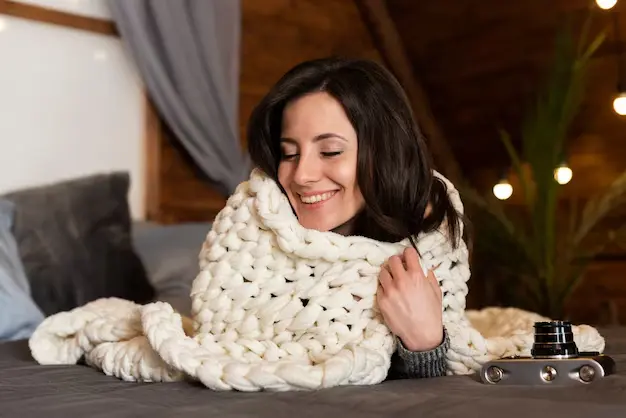A well-layered bed isn’t just about looks—it’s about comfort, warmth, and creating a space you can’t wait to sink into at the end of the day. Whether dressing in a queen-size bed or just adding a throw to your couch, the right layering technique makes all the difference. From choosing the right bedding to mixing textures and weights, this guide will walk you through everything you need to know to create a perfectly layered blanket setup.
What Makes the Perfect Blanket Foundation?
Before diving into layering techniques, let’s discuss your base layer—the foundation that makes all other layers work better. A good mattress topper is like the unsung hero of comfortable bedding, providing that extra cushioning that makes every blanket layer above it feel more luxurious. For a queen-size bed, memory foam toppers between 2 and 4 inches thick offer the best balance of support and plushness.
If you sleep hot, consider a cooling gel-infused topper instead. This base layer improves comfort and helps regulate temperature throughout the night, making your blanket layers more effective. According to sleep studies, proper foundational support can improve sleep quality by up to 30%, so don’t skip this crucial step. The right foundation means you’ll need fewer heavy blankets for the same cozy effect.
Why Should You Layer Blankets and Throws?
Layering isn’t just for fashion—it’s a practical way to adjust warmth and style throughout the year. A mattress topper adds softness, while multiple blanket layers let you add or remove warmth as needed. Throws add texture and color, turning a basic bed into a designer-worthy centerpiece. Plus, layering helps distribute weight evenly, making your bed feel more luxurious.
What Are the Best Blanket Materials for Layering?
Not all blanket fabrics work well together. The key is mixing textures and weights for both comfort and style.
- Cotton Blankets – Lightweight and breathable, perfect for summer or as a base layer.
- Wool or Cashmere is great for insulation in winter but can be heavy, so layer it over lighter fabrics.
- Fleece or Sherpa – Soft and warm, ideal for cozying up on chilly nights.
- Knit or Woven Throws Add visual interest and are easy to drape over furniture.
For a queen size bed, start with a fitted sheet, add a lightweight blanket, then top with a heavier one for adjustable warmth.

How Do You Layer Blankets for Different Seasons?
Your bedding needs to change with the weather, so your layering should, too.
Summer Layering
In the hot months, less is more. Use a breathable cotton or linen blanket as your top layer. A lightweight throw at the foot of the bed adds style without overheating. Skip heavy fabrics like wool and opt for moisture-wicking materials instead.
Winter Layering
When temperatures drop, start with a mattress topper for extra warmth. Add a medium-weight blanket, then a thick duvet or quilt. Finish with a chunky knit throw for texture and extra insulation.
What’s the Best Way to Style Throws on a Bed?
Throws aren’t just functional—they’re decorative. Here’s how to make them look effortlessly stylish:
- The Diagonal Drape – Fold a throw in half and drape it diagonally across one corner of the bed. This works well with patterned or textured throws.
- The Foot-of-Bed Fold – Neatly fold a throw and place it horizontally at the end of the bed for a clean, hotel-like look.
- The Casual Toss – For a relaxed vibe, loosely drape a throw over one side of the bed, letting it spill slightly onto the floor.
How Can You Mix Patterns and Colors Without Overdoing It?
Too many clashing prints can make your bedding look messy. Follow these rules:
- Stick to a Color Palette – Choose 2-3 main colors and vary shades for depth.
- Balance Patterns and Solids – If your blanket has a bold print, keep sheets and pillowcases neutral.
- Vary Texture Instead of Color – Mix a cable-knit throw with a smooth quilt for contrast if you prefer monochrome.
What’s the Best Layering Order for Maximum Comfort?
For the coziest setup, follow this sequence:
- Mattress Topper – Adds softness and regulates temperature.
- Fitted Sheet – Smooth foundation for other layers.
- Flat Sheet (Optional) – Traditional for a crisp feel.
- Light Blanket – Thin cotton or linen for breathability.
- Medium/Heavy Blanket – Wool or fleece for warmth.
- Duvet or Quilt – The top layer for style and insulation.
- Throw Blanket – Final decorative touch.
How Do You Keep Layered Blankets from Slipping?
Nothing’s worse than waking up to a tangled mess. Try these tricks:
- Use a Duvet Cover – Keeps thicker blankets in place.
- Tuck in Layers – Secure the bottom of sheets and light blankets under the mattress.
- Add a Weighted Blanket on Top – Helps hold everything together.

How to Maintain Your Layered Blanket System
Now that you’ve created the perfect blanket arrangement, let’s discuss keeping it fresh and functional. Rotate your blankets seasonally – store heavy winter woolens in breathable cotton bags during summer. For daily maintenance, shake out your throws and smooth your top blanket to prevent uneven wear. Most bedding experts recommend washing your middle-layer blankets every 2-3 weeks, while your decorative top throws can go longer between cleanings.
When storing extra blankets for a queen size bed, fold them with acid-free tissue paper to prevent creases. A little care goes a long way – properly maintained bedding can last 5-7 years longer than neglected pieces. Remember to fluff your mattress topper monthly to maintain its supportive qualities.
Conclusion
Layering blanket and throw combinations is an easy way to upgrade your bedding for both comfort and style. Whether you prefer a minimalist look or a cozy, textured feel, the right mix of fabrics and techniques can transform your bed into a sanctuary.
Ready to refresh your queen size bed? Explore premium blanket and throw options at Yintex Textile for the perfect layered look.


Leave a Reply